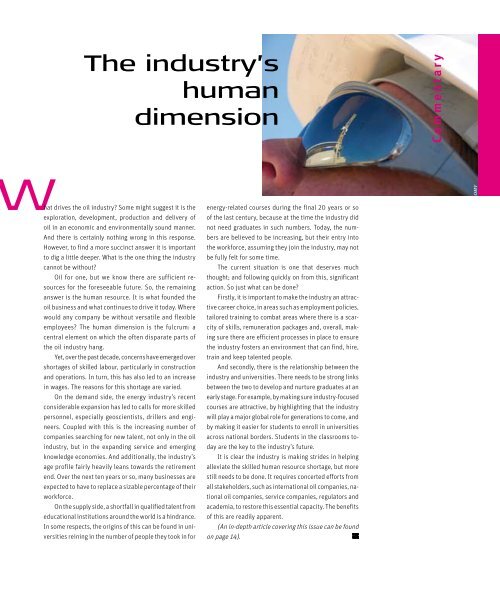Create successful ePaper yourself
Turn your PDF publications into a flip-book with our unique Google optimized e-Paper software.
The industry’s<br />
human<br />
dimension<br />
hat drives the oil industry? Some might suggest it is the<br />
exploration, development, production and delivery of<br />
oil in an economic and environmentally sound manner.<br />
And there is certainly nothing wrong in this response.<br />
However, to find a more succinct answer it is important<br />
to dig a little deeper. What is the one thing the industry<br />
cannot be without?<br />
Oil for one, but we know there are sufficient resources<br />
for the foreseeable future. So, the remaining<br />
answer is the human resource. It is what founded the<br />
oil business and what continues to drive it today. Where<br />
would any company be without versatile and flexible<br />
employees? The human dimension is the fulcrum: a<br />
central element on which the often disparate parts of<br />
the oil industry hang.<br />
Yet, over the past decade, concerns have emerged over<br />
shortages of skilled labour, particularly in construction<br />
and operations. In turn, this has also led to an increase<br />
in wages. The reasons for this shortage are varied.<br />
On the demand side, the energy industry’s recent<br />
considerable expansion has led to calls for more skilled<br />
personnel, especially geoscientists, drillers and engineers.<br />
Coupled with this is the increasing number of<br />
companies searching for new talent, not only in the oil<br />
industry, but in the expanding service and emerging<br />
knowledge economies. And additionally, the industry’s<br />
age profile fairly heavily leans towards the retirement<br />
end. Over the next ten years or so, many businesses are<br />
expected to have to replace a sizable percentage of their<br />
workforce.<br />
On the supply side, a shortfall in qualified talent from<br />
educational institutions around the world is a hindrance.<br />
In some respects, the origins of this can be found in universities<br />
reining in the number of people they took in for<br />
energy-related courses during the final 20 years or so<br />
of the last century, because at the time the industry did<br />
not need graduates in such numbers. Today, the numbers<br />
are believed to be increasing, but their entry into<br />
the workforce, assuming they join the industry, may not<br />
be fully felt for some time.<br />
The current situation is one that deserves much<br />
thought; and following quickly on from this, significant<br />
action. So just what can be done?<br />
Firstly, it is important to make the industry an attractive<br />
career choice, in areas such as employment policies,<br />
tailored training to combat areas where there is a scarcity<br />
of skills, remuneration packages and, overall, making<br />
sure there are efficient processes in place to ensure<br />
the industry fosters an environment that can find, hire,<br />
train and keep talented people.<br />
And secondly, there is the relationship between the<br />
industry and universities. There needs to be strong links<br />
between the two to develop and nurture graduates at an<br />
early stage. For example, by making sure industry-focused<br />
courses are attractive, by highlighting that the industry<br />
will play a major global role for generations to come, and<br />
by making it easier for students to enroll in universities<br />
across national borders. Students in the classrooms today<br />
are the key to the industry’s future.<br />
It is clear the industry is making strides in helping<br />
alleviate the skilled human resource shortage, but more<br />
still needs to be done. It requires concerted efforts from<br />
all stakeholders, such as international oil companies, national<br />
oil companies, service companies, regulators and<br />
academia, to restore this essential capacity. The benefits<br />
of this are readily apparent.<br />
(An in-depth article covering this issue can be found<br />
on page 14).<br />
Commentary<br />
OMV
















